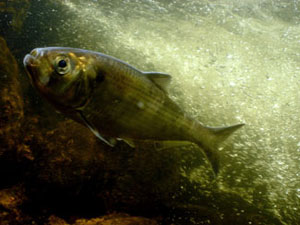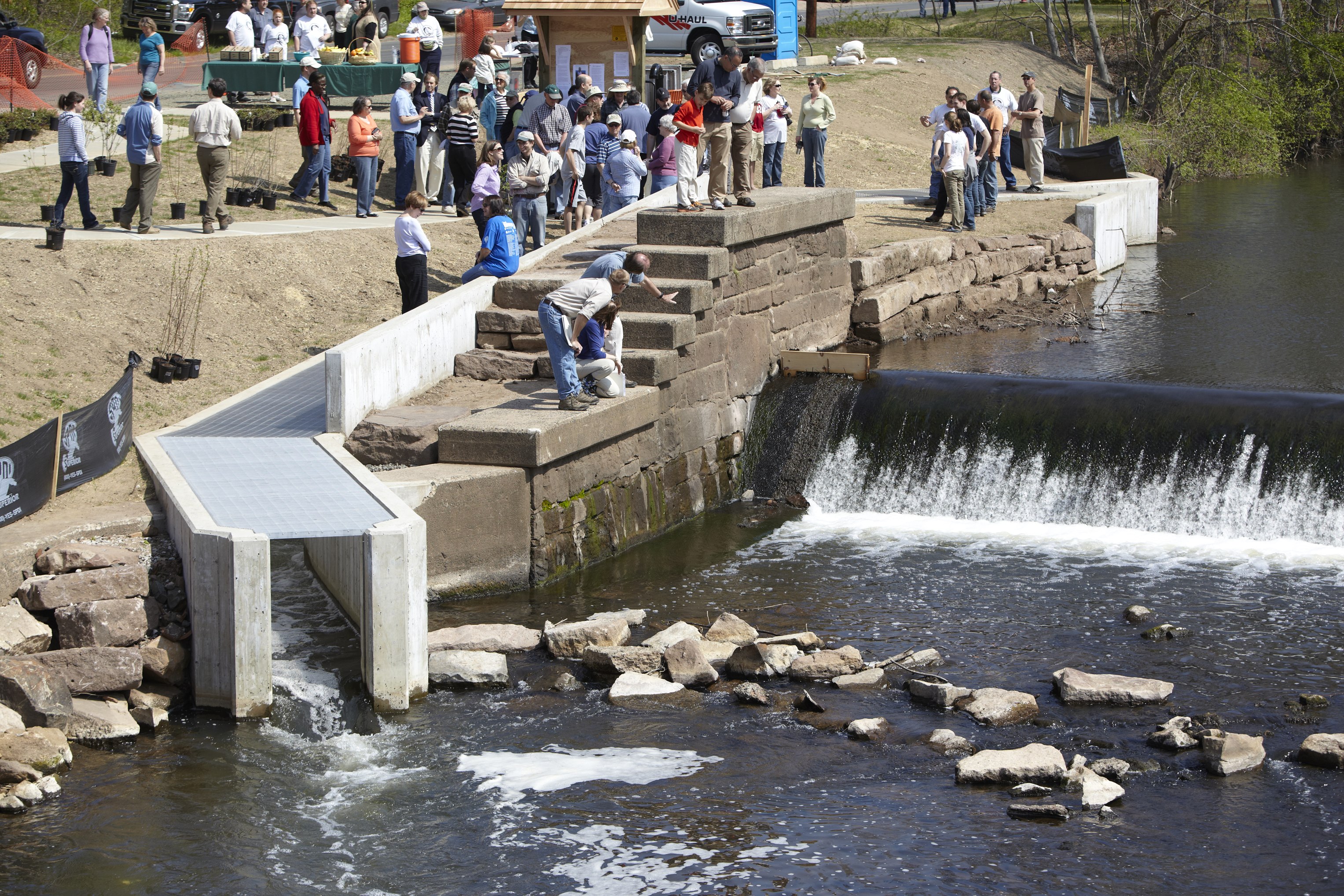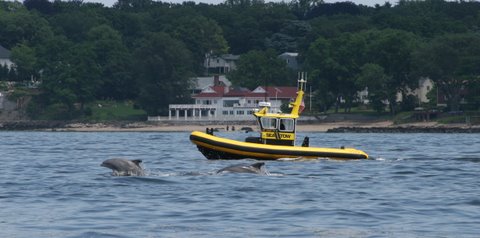For thousands of years, Connecticut’s streams and rivers have witnessed an amazing annual rite of passage. Every spring, alewife and blueback herring, collectively known as river herring, travel from the ocean to freshwater to spawn. After hatching, the young remain in freshwater to grow, and in the fall, return to Long Island Sound. The river herring will spend up to four years in the ocean before returning to their native waters to lay their eggs and begin the process again.

River herring and other small fish are called forage fish. They are extremely important to marine ecosystems, and provide a food source for many larger fish including striped bass and tuna, birds such as ospreys and cormorants, as well as mammals like seals and dolphin.
But river herring face two formidable obstacles in their cyclical journey—the 5,500 dams and obstructions on our Connecticut rivers and streams, and the commercial fishing industry that catches large numbers of river herring at sea.
We, along with many partners, have been working hard to build fishways and remove dams on high priority rivers and streams to help river herring and other migratory species bypass man-made obstructions and get to their spawning habitat. Forty-three fishways have been built and 12 dams have been removed, opening more than 295 miles of river habitat. Connecticut is a leader in this type of restoration work.

Despite restoration successes, the overall population trend of river herring is on the decline. Historically, millions of river herring returned to Connecticut’s rivers and streams each year. More than 630,000 blueback herring passed over the Holyoke, MA, dam on the Connecticut River in 1985. By 2006, only 21 passed the Holyoke Dam, the lowest number in the history of the Holyoke Fishlift. Last year, that number was only 39.¹ Because of the continued diminished numbers of river herring, the Connecticut Department of Energy and Environmental Protection determined that it would again extend a ban on the taking of alewives and blueback herring through March 2014.
No one knows the exact causes of the decline and worryingly, it isn’t just here in Connecticut—it’s been observed all along the East Coast.
Northeast Fisheries Observer Program data shows that between two and five million alewife and blueback herring were caught annually between 2005 and 2010, with the majority taken as bycatch in the trawl fishery for Atlantic herring in New England. Bycatch are fish caught unintentionally by boats targeting a different species. In some instances, hundreds of thousands of river herring have been removed in single net tows, designed to catch the Atlantic herring. Considering that up to a half million river herring can be destroyed by a single net tow, this is the rough equivalent of the total number of river herring monitored this spring passing up 14 of Long Island Sound’s most productive rivers.²
Over the past year, the New England Fishery Management Council adopted new rules and methods for commercial fishermen in the ocean to minimize river herring bycatch in the Atlantic herring fishery off the coast of northeastern states. Save the Sound and other advocates who attended public hearings and helped gain support for the passage of the new rules currently await their implementation. (Read our comments on the rules here: CFE-Save The Sound Amendment 5 Public Comment 06-21-2013.)
Although fishing councils can consider forage fish stocks and predator-prey dynamics as they develop their management plans, they do not have the legal mandate to do so. For example, there is no requirement to set forage fish catch limits low enough to account for the needs of the fish and wildlife that depend upon them for food.³ We think that needs to change. That is why Save the Sound supports the adoption of ecosystem-based fisheries management which takes into consideration forage fish and habitat management. We must ensure that there are enough river herring and other forage fish in the ocean to feed the larger fish and wildlife in the ecosystems of Long Island Sound and the ocean beyond.

There is a new opportunity on the horizon to protect river herring populations and the larger species of fish that depend on them. Congress is beginning the process to reauthorize the Magnuson-Stevens Act—the law that governs our nation’s ocean fisheries. The Magnuson-Stevens Act has been instrumental in rebuilding depleted fish species. Thirty-two fishery stocks have been rebuilt since 2012. But we must strengthen forage fish protections. And as Congress moves through the reauthorization process, we must ensure that policy makers adopt an ecosystem-based approach to fisheries management.
For more information about the Magnuson-Stevens Act and ecosystem-based fisheries management, we found a great report by the Pew Charitable Trusts and the Ocean Conservancy. Check out “It’s a Keeper” to learn more.
Stay tuned to our blog for an ongoing series on protecting forage fish in the Magnuson-Stevens Act…
¹ “Prohibition on the Taking of Alewife and Blueback Herring from Connecticut Waters Extended for another Year”. Connecticut Department of Energy and Environmental Protection, 15 April 2013. Web. 02 Aug. 2013. http://www.ct.gov/deep/cwp/view.asp?Q=522342&A=4380
² “Weekly Diadromous Fish Report”, Connecticut Department of Energy and Environmental Protection, Inland Fisheries Division.13 Jun. 2013. PDF file.
³ “It’s a Keeper: The Law That’s Saving American Fisheries: The Magnuson-Stevens Fishery Conservation and Management Act”. The Pew Charitable Trusts and Ocean Conservancy. May 2013. 35-36. Web. 02 Aug. 2013 http://www.pewenvironment.org/uploadedFiles/PEG/Publications/Report/FF-MSA-Report-2013-Final.pdf
Posted by Chris Cryder, Special Project Coordinator for Save the Sound

Scary statistics about the bycatch. We have to be more careful! I’m glad you guys are so strongly behind this work. It’s very reminiscent of the salmon out here – not the bycatch issue, but they’re still negatively impacted by barriers to migration. Thanks for posting this!
Very true–dams and other barriers affect lots of species. We’re working with a number of partners here in the Long Island Sound region to remove dams that are no longer needed and to construct fishways to let fish safely migrate past others. Legislation passed in CT last year should encourage more frequent inspection of dams, and a similar program in MA found that this led to more private landowners removing small dams on their property. Good news!
American Rivers, another organization working on dam removal, has a great FAQ on the subject: http://www.americanrivers.org/initiatives/dams/faqs/